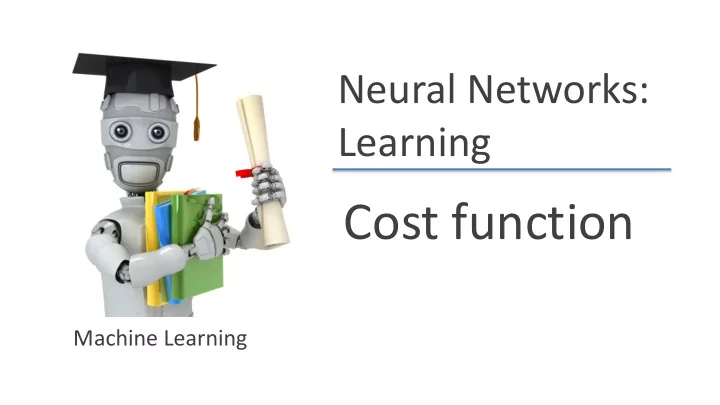

Neural Networks: Learning Cost function Machine Learning
Neural Network (Classification) total no. of layers in network no. of units (not counting bias unit) in layer Layer 1 Layer 2 Layer 3 Layer 4 Multi-class classification (K classes) Binary classification E.g. , , , pedestrian car motorcycle truck 1 output unit K output units Andrew Ng
Cost function Logistic regression: Neural network: Andrew Ng
Neural Networks: Learning 역전파 알고리즘 ( Backpropagation ) Machine Learning
Gradient computation Need code to compute: - -
Gradient computation 주어진 하나의 훈련자료 ( , ): 전방향전파 (Forward propagation): Layer 1 Layer 2 Layer 3 Layer 4
Gradient computation: 역전파 (Backpropagation) 알고리즘 Intuition: “error” of node in layer . For each output unit (layer L = 4) Layer 1 Layer 2 Layer 3 Layer 4
Backpropagation algorithm Training set Set (for all ). For Set Perform forward propagation to compute for Using , compute Compute
Neural Networks: Learning Backpropagation intuition Machine Learning
Forward Propagation
Forward Propagation Andrew Ng
What is backpropagation doing? Focusing on a single example , , the case of 1 output unit, and ignoring regularization ( ), (Think of ) I.e. how well is the network doing on example i? Andrew Ng
Forward Propagation “error” of cost for (unit in layer ). Formally, (for ), where Andrew Ng
Neural Networks: Learning Implementation note: Unrolling parameters Machine Learning
Advanced optimization function [jVal, gradient] = costFunction(theta) … optTheta = fminunc(@costFunction, initialTheta, options) Neural Network (L=4): - matrices ( Theta1, Theta2, Theta3 ) - matrices ( D1, D2, D3 ) “Unroll” into vectors Andrew Ng
Example thetaVec = [ Theta1(:); Theta2(:); Theta3(:)]; DVec = [D1(:); D2(:); D3(:)]; Theta1 = reshape(thetaVec(1:110),10,11); Theta2 = reshape(thetaVec(111:220),10,11); Theta3 = reshape(thetaVec(221:231),1,11); Andrew Ng
Learning Algorithm Have initial parameters . Unroll to get initialTheta to pass to fminunc(@costFunction, initialTheta, options) function [jval, gradientVec] = costFunction(thetaVec) From thetaVec, get . Use forward prop/back prop to compute and . Unroll to get gradientVec. Andrew Ng
Neural Networks: Learning Gradient checking Machine Learning
Numerical estimation of gradients Implement: gradApprox = (J(theta + EPSILON) – J(theta – EPSILON)) /(2*EPSILON) Andrew Ng
Parameter vector (E.g. is “unrolled” version of ) Andrew Ng
for i = 1:n, thetaPlus = theta; thetaPlus(i) = thetaPlus(i) + EPSILON; thetaMinus = theta; thetaMinus(i) = thetaMinus(i) – EPSILON; gradApprox(i) = (J(thetaPlus) – J(thetaMinus)) /(2*EPSILON); end; Check that gradApprox ≈ DVec Andrew Ng
Implementation Note: - Implement backprop to compute DVec (unrolled ). - Implement numerical gradient check to compute gradApprox . - Make sure they give similar values. - Turn off gradient checking. Using backprop code for learning. Important: - Be sure to disable your gradient checking code before training your classifier. If you run numerical gradient computation on every iteration of gradient descent (or in the inner loop of costFunction (…) )your code will be very slow. Andrew Ng
Neural Networks: Learning Random initialization Machine Learning
Initial value of For gradient descent and advanced optimization method, need initial value for . optTheta = fminunc(@costFunction, initialTheta, options) Consider gradient descent Set ? initialTheta = zeros(n,1) Andrew Ng
Zero initialization After each update, parameters corresponding to inputs going into each of two hidden units are identical. Andrew Ng
Random initialization: Symmetry breaking Initialize each to a random value in (i.e. ) E.g. Theta1 = rand(10,11)*(2*INIT_EPSILON) - INIT_EPSILON; Theta2 = rand(1,11)*(2*INIT_EPSILON) - INIT_EPSILON; Andrew Ng
Neural Networks: Learning Putting it together Machine Learning
Training a neural network Pick a network architecture (connectivity pattern between neurons) No. of input units: Dimension of features No. output units: Number of classes Reasonable default: 1 hidden layer, or if >1 hidden layer, have same no. of hidden units in every layer (usually the more the better) Andrew Ng
Training a neural network 1. Randomly initialize weights 2. Implement forward propagation to get for any 3. Implement code to compute cost function 4. Implement backprop to compute partial derivatives for i = 1:m Perform forward propagation and backpropagation using example (Get activations and delta terms for ). Andrew Ng
Training a neural network 5. Use gradient checking to compare computed using backpropagation vs. using numerical estimate of gradient of . Then disable gradient checking code. 6. Use gradient descent or advanced optimization method with backpropagation to try to minimize as a function of parameters Andrew Ng
Andrew Ng
Neural Networks: Learning Backpropagation example: Autonomous driving (optional) Machine Learning
[Courtesy of Dean Pomerleau]
Recommend
More recommend